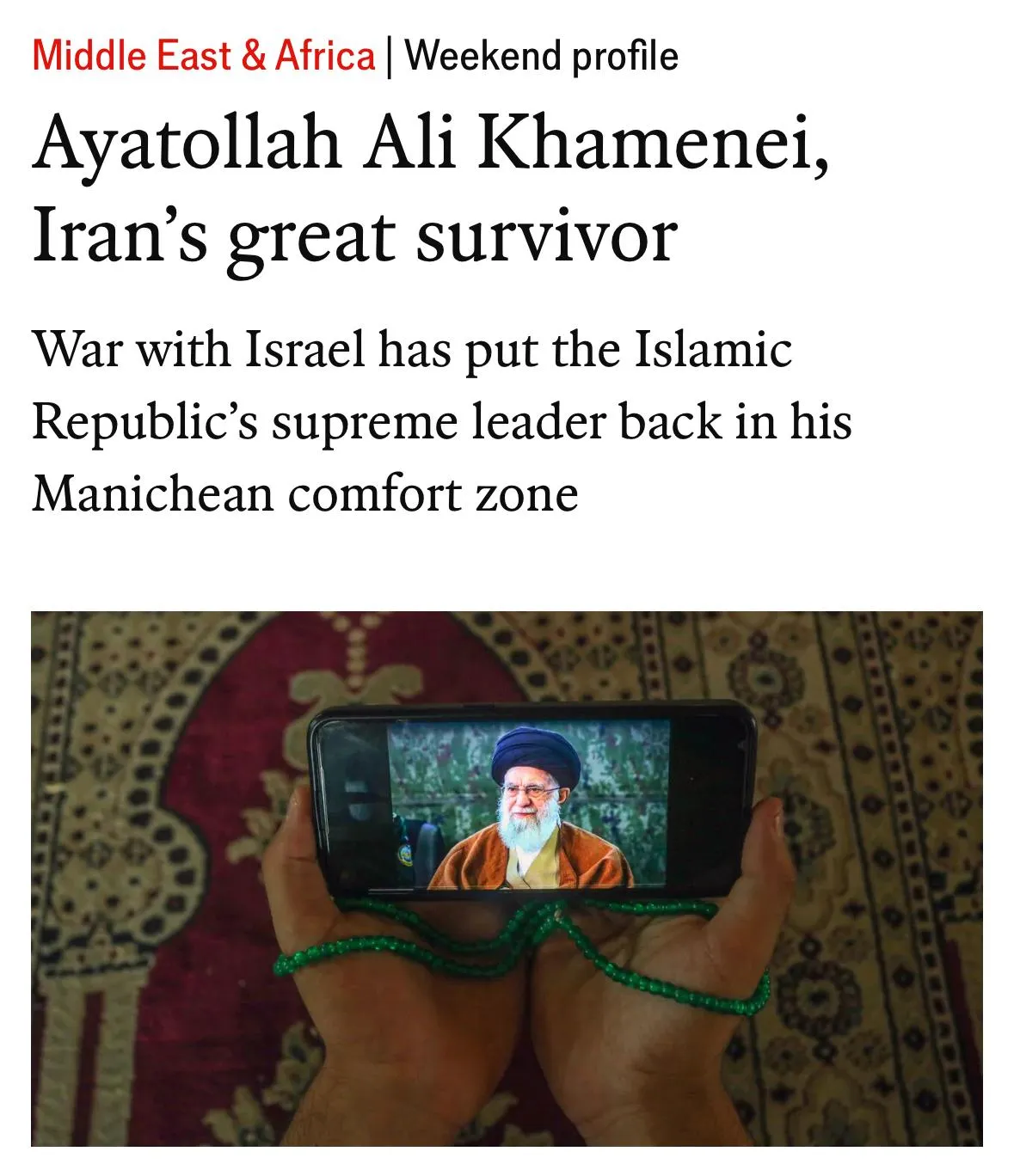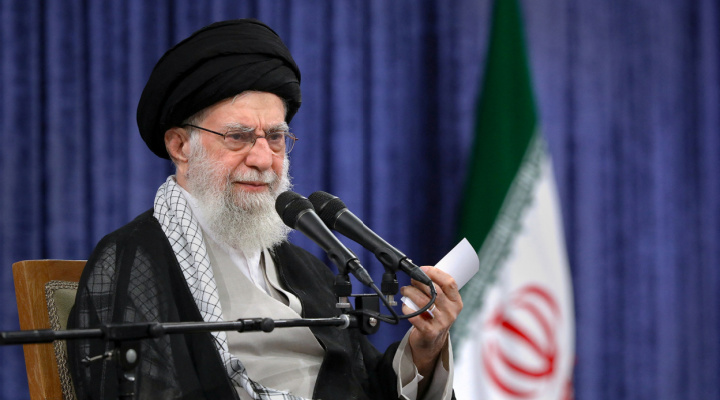Iran’s Supreme Leader Ayatollah Ali Khamenei speaks during a meeting in Tehran, Iran, May 20, 2025. Photo: Office of the Iranian Supreme Leader/WANA (West Asia News Agency)/Handout via REUTERS
Since the start of Israel’s war with Iran, the media have been preoccupied with a question on many people’s minds: who would take over if Ayatollah Ali Khamenei were killed or deposed?
The result has been a trickle of “explainers” and backgrounders about the aging Supreme Leader — pieces that, predictably, can’t resist the urge to “humanize” one of the world’s most repressive autocrats.
Not content to describe Khamenei as the brutal theocrat he is, several outlets have instead presented a portrait of a soft-spoken, book-loving, poetry-reciting underdog who just happens to run the globe’s most prolific state sponsor of terrorism.
We’ve seen this troubling trend before. After Hezbollah leader Hassan Nasrallah was eliminated last year, media profiles described him as “charismatic,” “revered,” and portrayed him as a kind of grandfatherly figure.
The media are calling Iran’s Supreme Leader a “gardener” and an “underdog.”
They forgot:
– Thousands executed
– Women jailed for showing their hair
– Protesters shot in the streets
– Terrorists armed across the regionStop romanticizing tyrants. Start telling the truth. pic.twitter.com/eIBe5QuPqq
— HonestReporting (@HonestReporting) June 22, 2025
The Economist led the way this time, with a piece published on June 21, just hours before the United States formally entered Israel’s war against Iran by striking the regime’s nuclear sites.
Titled “Ayatollah Ali Khamenei, Iran’s Great Survivor,” the article describes him as “an underdog from the start,” one of eight children born to a “poor religious scholar from the north-east of Iran.” We’re told he studied the Koran, “listened to music, recited poetry and read novels such as Les Misérables and The Grapes of Wrath” — books that, The Economist implies, resonated with Khamenei because they “depict secular struggles against oppression.”
It’s all very literary. The Ayatollah, we’re to understand, is not just the man behind a brutal theocracy; he’s also a fan of Steinbeck, a name familiar to every American high schooler.

The profile continues with an overview of Khamenei’s political scheming and rise to power, along with a surprisingly admiring assessment of his “astute business mind.” The tone is often reverent, at times barely concealing its awe.
By contrast, Khamenei’s less impressive traits — his penchant for executing political opponents, crushing dissent, and sponsoring global terrorism — are buried deep in the article and softened when they finally appear. There is no mention of his role in turning Iran into the world’s foremost state sponsor of terror, funding groups like Hamas, Hezbollah, and the Houthis.
Instead, we’re told that Iran’s transformation “from hybrid-democracy into dictatorship” merely “stirred dissent.” Women, we’re informed, have simply “resented” being forced into black manteaux and headscarves. And the regime’s violent suppression of protests? That’s summed up as “beating, shooting, jailing and kangaroo courts.” Polite euphemisms for what has, in fact, been mass repression and execution.
It’s worth noting that 2024 was reportedly a record year for executions in Iran, with at least 1,000 carried out across 86 prisons. Among the victims were 34 women, seven juvenile offenders, and four people publicly hanged.
The Economist closes with an ominous warning to Israel and the West: Khamenei: “should not be underestimated.” The tone borders on admiring, as if the anonymous writer is almost rooting for the Ayatollah to make a defiant comeback.
View this post on Instagram
And The Economist wasn’t alone.
An essay in The Conversation titled “Who is Iran’s leader, Ayatollah Ali Khamenei?” manages to explore that very question without a single mention of Iranian terror proxies or the regime’s execution record. But it does find space to note Khamenei’s “rare” literary interests and “his interest in gardening.” Yes, gardening — a charming detail about a man whose government regularly hangs dissidents from cranes.
Meanwhile, an almost identically titled explainer in The New York Times breezes past Khamenei’s transformation of Iran into a regional menace.
We’re told that after Ayatollah Khomeini’s death in 1989, Khamenei simply “set about consolidating control of the country’s political, military and security apparatus, and cracking down on dissent to shore up his position.” A tidy summary for what has, in reality, been decades of authoritarian rule and bloodshed.

To be fair, not all media outlets have followed suit.
Some have provided more balanced coverage, reminding readers of events that made global headlines just a few years ago — like the widespread protests sparked by the murder of Mahsa Amini, the young Kurdish woman beaten to death by Iran’s morality police for wearing her headscarf “improperly.” The regime’s response to those protests was swift and brutal: hundreds killed, thousands jailed, and countless lives destroyed.
These are the facts about Khamenei that readers deserve to be reminded of. Not his supposed sensitivity to Western novels, or his affection for flowers.
Because the truth is, Ayatollah Ali Khamenei doesn’t just oversee a regime that terrorizes its own people. He presides over one that seeks to export that terror to the rest of the world.
That’s who he really is.
The author is a contributor to HonestReporting, a Jerusalem-based media watchdog with a focus on antisemitism and anti-Israel bias — where a version of this article first appeared.
The post Media Fawns Over Ayatollah Khamenei’s ‘Gardening’ Skills; Forgets the Executions first appeared on Algemeiner.com.
Click this link for the original source of this article.
Author: Rachel O’Donoghue
This content is courtesy of, and owned and copyrighted by, https://www.algemeiner.com and its author. This content is made available by use of the public RSS feed offered by the host site and is used for educational purposes only. If you are the author or represent the host site and would like this content removed now and in the future, please contact USSANews.com using the email address in the Contact page found in the website menu.








